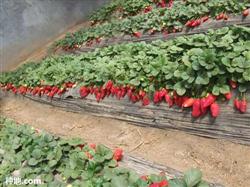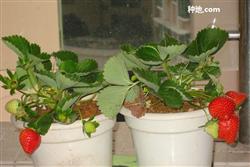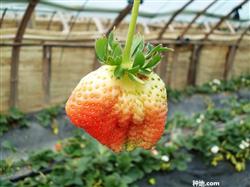How to manage strawberries in spring?

How to manage strawberries in spring? Please guide the key points of strawberry management in spring: strengthening the spring management of strawberries in open field is the key to promote early fruiting, excellent quality and high yield of strawberries. The measures are as follows: when the average temperature of the day is about 10 ℃, the cold mulch on strawberry seedlings can be removed one after another. Be careful not to break the flower buds. Such as the use of film coverage, when uncovering the film, it is necessary to do a good job of refining seedlings to prevent sudden excessive temperature difference, affecting the growth and development of strawberries. Timely ploughing and weeding of old leaves after the beginning of spring, ploughing and weeding should be done in time, but it should be shallower when ploughing, strictly prevent the soil clods from crushing the seedlings, and clear the drainage ditches, at the same time, remove the old, withered and diseased leaves of strawberries to prevent the spread of disease. Pay close attention to fertilization to promote early onset after a winter dormancy, after the beginning of spring, the temperature rises and strawberries begin to grow. Timely topdressing can promote the early growth of the plant, form new leaves as soon as possible, increase the number of effective flowers and increase the fruit setting rate. Because strawberry has shallow roots, sensitive to fertilizer and prone to fertilizer damage, urea, compound fertilizer or human feces and urine should be used to avoid the use of ammonium bicarbonate. The usage should be mastered with urea 5kg / mu, human feces and urine 1000kg / mu, compound fertilizer 10kg / mu, combined with fertilization and watering once. Foliar spraying 0.2% potassium dihydrogen phosphate solution twice during flowering and fruiting period has a good effect on improving quality and increasing yield. Watering should be done with small amount of water to keep the land moist. After entering the fruit ripening period, water should be properly controlled. During drought, small water should be irrigated in the evening after each fruit harvest, and do not flood irrigation, otherwise it is easy to infect diseases and cause a large number of rotten fruits. After the inflorescence is produced on the new stem of strawberry, there are generally 10-30 flowers per inflorescence, too many buds, insufficient nutrient supply, weak growth, small fruit and abnormal fruit will increase. Therefore, after budding, thin buds should be removed, flowers should be thinned again in full bloom, nutrition should be concentrated to supply large flowers, fruit setting rate and single fruit weight should be increased, buds should be thinned and flowers should be thinned, with 2-3 inflorescences per plant and 3-5 fruits per inflorescence. After setting fruit and harvesting strawberries, with the increase of the fruit, the ear will droop, and the wheat straw should be placed under the ear in time to prevent the fruit from contacting with the ground, pollution or rotten fruit. When the fruit noodles are colored, harvest should be done in the morning after the dew is dry, do not touch the pulp when picking, gently hold the handle, take part of the stalk and put it into a clean container, classify it, sell or process it immediately. To control diseases and insect pests, strawberry plants are short, creeping on the ground, blossom and fruiting for a long time, and the fruit is easy to touch the ground and vulnerable to diseases and insect pests, so comprehensive control measures must be adopted. The main diseases and insect pests are virus disease, powdery mildew, gray mold, brown spot and aphid underground pests and so on. 1. The fundamental measure of virus disease is to use virus-free seedlings to eradicate aphids. At the initial stage of the disease, 1.5% of Zhiyanling emulsion was sprayed 1000 times or 83 times the resistance agent. two。 Powdery mildew was treated with 12.5% nitrilazole EC 2000 times or 20% strychnine wettable powder 1000 times. 3. Botrytis cinerea uses 50% Nongliling wettable powder 800x solution or 50% Sukeling wettable powder 1000 times solution. 4. Brown spot disease uses 2% agricultural antibiotic 120 water agent 200 times or 50% methyl topiramate 500 times 1000 times. 5. Aphids use 2000 times of aldicarb wettable powder or 15002000 times of imidacloprid wettable powder. 6. Underground pests such as grubs and mole crickets are irrigated or irrigated with 80% trichlorfon wettable powder 200g / mu or 40% phoxim EC 200g / mu, 500kg / mu and 750kg water. Pay attention to stop taking medicine 15 days before fruit picking to prevent poisoning. Click to get more strawberry planting techniques click to get more fruit planting techniques
- Prev

How do you plant strawberries?
How do you plant strawberries? Please guide strawberry potted plants to refer to the following methods: first, select pots, soil and varieties. It is appropriate to choose ceramic pots with a diameter of 20-30 cm in pots. The basin soil is selected with high humus content. The varieties use European four Seasons Red, Changhong 2, 83-38 and other excellent four Seasons Strawberry varieties.
- Next

What about the deformity of strawberries planted in the greenhouse?
What about the deformity of strawberries planted in the greenhouse? Please guide the main reasons for strawberry malformation: low room temperature is a common cause of deformed fruit. The optimum temperature for strawberry growth and development is 20 ℃ ~ 25 ℃. The lowest temperature during flowering and fruiting period should not be lower than 5 ℃. If the temperature is below 5 ℃, it will seriously affect the growth and pollination of strawberries.
Related
- Moge, come on! The staff of the peasant association in the producing area of cantaloupe were frightened when the crowd gathered.
- Causes and Solutions of low Fruit setting rate of Apple
- Symptoms and control measures of passion fruit virus disease
- Fruit growing lesson: how do apple orchards keep high yields?
- Can you build orchards in the mountains? What are the pros and cons?
- How to manage the coloring period of Crisson grape?
- This paper introduces the processing technology of two kinds of fig products.
- How much is a month for retired teachers in rural areas by 2020?
- How can strawberry planting increase sugar content? We should pay attention to management in many aspects.
- What are the cultivation techniques on how to improve the yield of golden fruit?

